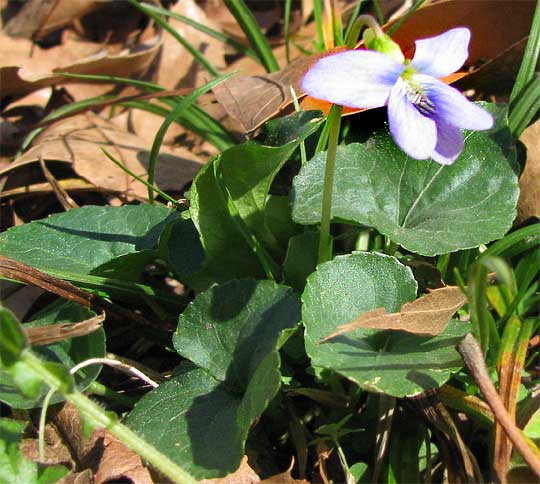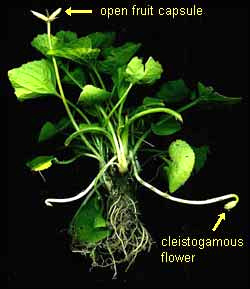Excerpts from Jim Conrad's
Naturalist Newsletter
from the February 16, 2009 Newsletter, issued from the forest near Natchez, Mississippi; elevation ~400ft (120m), ~N31.47°, ~W91.29°: Above you see a little violet currently poking up through the lawn grass and last year's leaves. It's the Common Blue Violet, VIOLA SORORIA, one of the best known of native North American wildflowers. I've written about this species before, especially how I like to eat its leaves in salads. The last time I mentioned that Genevieve of Natchez wrote telling me about her sister's violet-blossom jelly, which has a very delicate flavor and is great on homemade bread. Gloria in New York wrote saying that she candies the blossoms, but warned that
"they are very delicate and the sugar is very heavy so they kind of turn out like little sugarized violet blobs." Once you start wandering in the woods you'll be amazed at how many violet species turn up, including white-, yellow- and even green-flowered species. Twenty-two violet names are listed for Mississippi.
COMMON BLUE VIOLETS UP 
from the May 25, 2006 Newsletter, issued from near Natchez, Mississippi:
A VIOLET'S CLEISTOGAMOUS FLOWERS
I'm still eating violets. Their pretty, purple flowers are long gone but their fruiting capsules are now disseminating seeds from atop peduncles extending above the plant's deep green, heart-shaped leaves.
An interesting thing about violets -- members of the genus VIOLA -- is that most species, after producing regular blossoms, produce cleistogamous flowers, or "cleistogenes." That word "cleistogamous" is rooted in the ancient Greek "kleistos," meaning "closed," so cleistogamous flowers are closed flowers. They don't open up. They remain as closed buds. Consequently, pollinators such as bees never can get to the flowers' sexual parts, and the flowers are obliged to fertilize themselves with their own pollen. Often cleistogamous flowers are produced on sprawling peduncles or stolons that grow through the leaf litter or even underground.
 One morning this week as I was collecting leaves from the Common Purple Violet, VIOLA SORORIA, for the next day's breakfast, I found a plant beautifully showing not only two cleistogamous flowers but also a fruiting capsule held above its leaves. I scanned it and you can see the resulting image at the right.
One morning this week as I was collecting leaves from the Common Purple Violet, VIOLA SORORIA, for the next day's breakfast, I found a plant beautifully showing not only two cleistogamous flowers but also a fruiting capsule held above its leaves. I scanned it and you can see the resulting image at the right.
In that picture the two white, horizontal things are hook-necked peduncles that had been buried in the leaf litter. The cleistogamous flowers are the budlike things at the ends of the hooks. A fruiting capsule rises above the plant's leaves.
Of course, self-fertilizing like this, there is no mingling of genetic information from two different parents. However, this was accomplished with the regular flowers produced earlier in the season. These violets are telling us, then: That there's nothing sacred about always mixing genes. Sometimes a little kinkiness gets the job done as well.
In fact, fruit capsules developed from cleistogamous flowers typically produce lots of perfectly fertile seeds.